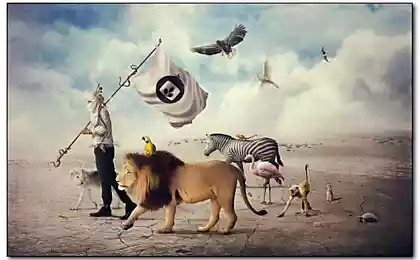890
The scientists compared the genomes of 29 mammals, including humans

A key step in understanding how the genome of thousands of mutations may be associated with human diseases, made by American and Swedish researchers who compared the genomes of 29 mammals, including humans.
95 percent of the human genome took a DNA sequence whose function is not yet established. The same DNA that the scientific community is called "junk" or "dark matter", there are other organisms. Deeper to find out "junk" DNA failed as a result of a large-scale study conducted by an international team of geneticists from the United States and Sweden, the results of which are published in the journal Nature.
The focus of the scientists proved the so-called regulatory sequences peculiar genetic bosses, which in itself is no information about the body does not seem to bear, but it controls the activity of genes, in particular, cutting them as needed, or, conversely, activating.
Map of regulatory elements, compiled by scientists, is a key step in understanding how the genome of thousands of mutations may be associated with human diseases.
Carried out before the study of mouse and human genomes have given grounds to speak about the existence of the genomes of animals in the presence of regulatory elements, but with the help of previous studies have found only a very small portion of these elements. To understand the situation more, scientists attracted to the study of whole menagerie, examining and comparing the genomes of 29 different mammals, including rabbits, rats, elephants, and, of course, man.
The sequencing of the genome took researchers five years, with 20 of these genomes are published for the first time.
As a result, it was discovered almost three million were not previously detectable elements "junk" DNA, which remain the same for all animals and the change in the human genome that is directly related to his illness.
Recall that DNA consists of four bases: adenine (A), cytosine ©, thymine (T) and guanine (G) and the order of these bases is said DNA sequence. After studying the genomes of its "zoo", the scientists were able to determine, if not, then at least to make assumptions about the functions of more than half of the 360 million sequences contained in these immutable elements of the genome. In particular, it is found almost 4000 not previously detected exons (regions of genes that carry information about the primary structure of the protein) and 10 thousands of elements with a high degree of safety, which may participate in the regulation process, when the body produces the desired protein. Also found more than a thousand new families of secondary structures of RNA that regulate the work of genes.
Compare helped researchers to understand how these animals evolved from the immutable part of their genome for more than a hundred million years. %% 5
"We were able to establish that all the animals regulatory elements are the same, - says one of the team members Eric Lander, director of the Broad Institute, who heads the study. - Their evolutionary changes caused by adaptation to different habitats and way of life have been, it seems programmed to 100 million years ago and is still taking place in the human genome ».
In addition to the discovery of regulatory immutable parts of the DNA that are common to all of the investigated "menagerie", the comparison also revealed a thousand regions of the genome that are rapidly changing only in humans and other higher primates.
According to scientists, it gives them a lot of starting points for the study of human evolution by DNA.
Methods of comparing a plurality of completely sequenced genomes are relatively new - if only because so many scientists until recently simply did not have. This technique can detect regions of the genome, which previously did not respond to the discovery. The more genomes of different species will be involved in such comparisons, the more effective will operate this new and truly a very powerful technique.
The genetic imprint of childhood man carries a lifetime
Earn their living by his own head (36 photos)























